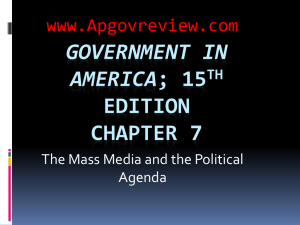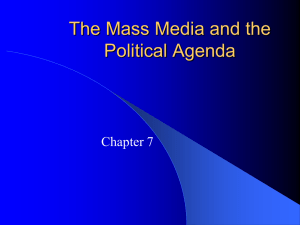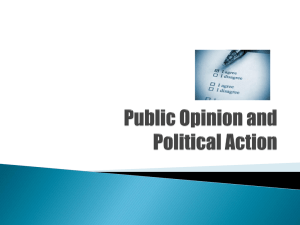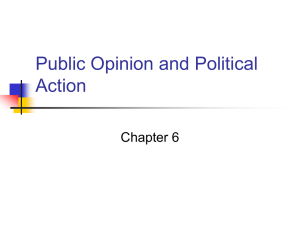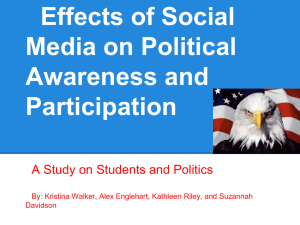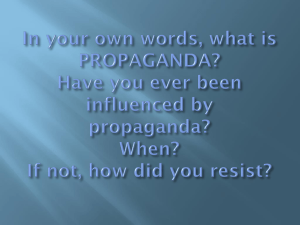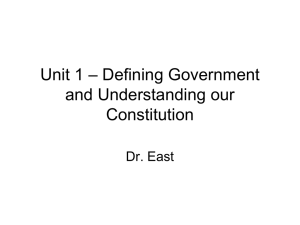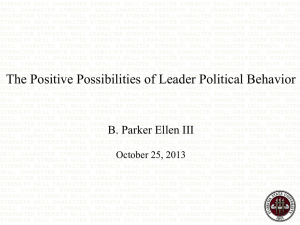Review PPT
advertisement
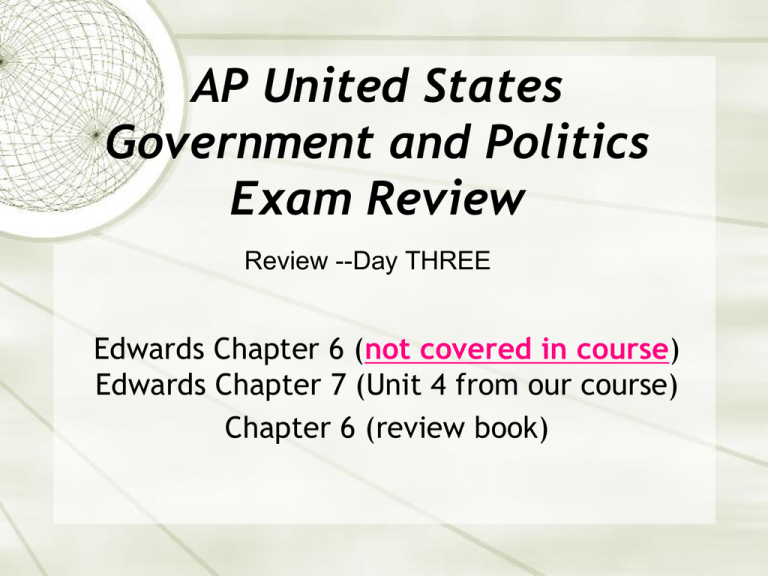
AP United States Government and Politics Exam Review Review --Day THREE Edwards Chapter 6 (not covered in course) Edwards Chapter 7 (Unit 4 from our course) Chapter 6 (review book) Public Opinion and Political Action Chapter 6 (Edwards) Public Opinion and Political Action More than two centuries of immigration to United States has created an incredibly diverse population of Americans Numerous social and economic factors therefore contribute to a varied forum of public opinion Despite differences, Americans overall share a common political culture based on democracy and federalism Today, public opinion can be a powerful tool, especially during elections politicians, pundits, and even voters pay close attention to what polls tell them is the public’s opinion The American People Constitution requires census be taken every 10 years census collects demographic data about the population of the United States information is used to: distribute money to federal and state programs, reapportion seats in the House to each state, determine each state’s number of electors in the Electoral College, redraw state and federal congressional districts, allocate funds for public services such as schools, roads, and public transportation The American People Census reports confirm United States a nation of immigrants, a melting pot of cultures, ideas, and people According to recent census data percentage of minorities is increasing while the percentage of Caucasians is decreasing could lead to a minority majority in the next few decades (Also) first time, Hispanic Americans outnumbered African Americans The American People Reapportionment in the last two decades has given more seats to the increasingly populated states of California, Florida, and Texas states in the Northeast have lost seats Senior Citizens make up the largest population group by age gives them significant political influence will put a serious strain on the Social Security system in the next few decade Despite ethnic, age, and geographic diversity, US has a shared political culture, with a common set of political values that are widely shared How Americans Learn About Politics: Political Socialization People learn about politics and form their political beliefs through the process of political socialization several different means through which people informally acquire political information How Americans Learn About Politics: Political Socialization Family: Families have a significant degree of influence, especially over younger members most people identify with the same party as their parents do Mass media: Most Americans, especially children and teenagers, watch a significant amount of television Political information is often disseminated through TV Younger people are much less likely to watch the news than are adults, however, and as a result, the political knowledge of young people today is significantly lower than that of young people a few decades ago How Americans Learn About Politics: Political Socialization School: Schools educate children in American values such as democracy and capitalism, both through academics and through practices such as reciting the Pledge of Allegiance good education also tends to produce more politically active and aware citizens young people also influenced by members of their peer group when formulating their political attitudes and beliefs How Americans Learn About Politics: Political Socialization Religious groups and associations influence political attitudes Example -- during the last decade, fundamentalist Christians have played an ever-increasing role in the politics of the US Socialization is a dynamic process, with learning taking place over one’s entire lifetime Socialization is part of the very important nurturing process Measuring Public Opinion and Political Information Polls are the most common means of assessing public opinion random sample, or a group that statistically represents the whole population of the US, is asked to fill out a questionnaire or answer some questions over the phone famous non-random sample The Literary Digest Poll of 1936, wrongly predicted that Republican Alf Landon would defeat Franklin Roosevelt in the election that year wording of a question is critical, and ambiguously worded questions can affect the accuracy of a poll size of the sample can also affect the accuracy of a poll and thus the level of confidence in the poll (sampling error) Measuring Public Opinion and Political Information Commonly, modern polls rely on random digit dialing to draw telephone samples Some critics argue that polls allow politicians to be influenced easily by shifts in public opinion and that polls receive more media attention than do candidates’ political platforms during elections Others assert that, by advancing the public’s political agenda to poll-sensitive politicians, polls advance the principles of democracy Measuring Public Opinion and Political Information Recent polls indicate that Americans have little political knowledge and little faith that the government is acting on their behalf Exit polls are conducted by media as voters leave the voting booth to predict the outcomes of elections Public opinion polls have shown a trend indicating that Americans trust government less than they used to What Americans Value: Political Ideologies Conservative ideology: Favors limited government and freedom of the private sector more likely to support military spending, free markets, prayer in school, and reduced taxes opposes abortion, affirmative action, and government spending on social programs What Americans Value: Political Ideologies Liberal ideology: Favors an active central government with social and economic responsibilities Favors a more equal distribution of wealth, more government regulation of big business, more government spending on social programs, and abortion Opposes increases in defense spending and military actions, prayer in school, and tax breaks for the wealthy What Americans Value: Political Ideologies Women and minorities tend to be more liberal gender gap pattern that predicts that women are more likely to vote for a Democratic candidate; however this was less prevalent in the 2004 elections Traditionally, people of higher socioeconomic classes tend to be conservative trend is declining Conservative groups tend to have more resources and therefore more political power Ronald Reagan was one of the most conservative presidents of the 20th century Bill Clinton shifted the Democratic Party and government back to a more centrist position How Americans Participate in Politics Americans express their political views and try to influence policy by voting, petitioning, participating in protests, or corresponding with their representatives Voter turnout has been declining (2008 - exception) over the last few decades, though it is still the most common way people participate in politics Young people are the group least likely to vote Campaign contributions to candidates as a form of political participation are on the rise. How Americans Participate in Politics Protest and civil disobedience have a long tradition in American history Protests against globalization and war continue to be a means of political expression today TEA Party today classic example People of high socioeconomic status are much more likely to participate in politics, although African Americans and Hispanic Americans are becoming more active The Mass Media and the Political Agenda Chapter 7 The Mass Media and the Political Agenda mass media, including newspapers, radio, television, and the Internet have had a profound impact on politics In today’s media-savvy world, politicians are highly visible to the public this has had both positive and negative consequences for policymakers, campaigns, and the public’s trust in government impact of the media on American politics is referred to as high-tech politics, in which thee media can shape the political agenda and the behavior of policy makers The Mass Media Today Political leaders have learned to use the media to set their agenda media event is an event that is staged by a political leader with the purpose of getting it covered in the media to shape an image or draw attention to a chosen issue political leaders can more deliberately use advertisements to make up the majority of spending on political campaigns Presidents also use the media to make direct appeals to the public. The Development of Media Politics Politics and the mass media go hand in hand (whereas) once they worked together to communicate with the public, today they often oppose each other Press conferences are a common means by which presidents convey their goals and opinions to the public recent phenomenon begun by Franklin Roosevelt in the 1930s FDR first president to address the electorate directly through the radio The Development of Media Politics Watergate scandal and the Vietnam War changed the government’s relationship with the press, as the press became more suspicious about political motives Today the media engage in investigative journalism, often with the intent of revealing scandals The Print Media Only a few corporations own all the newspapers in the United States, as well as radio and television stations These major corporations have significant control over information conveyed in the media Newspaper readers tend to be politically informed, active citizens, but newspaper circulation has been declining since the advent of television The Broadcast Media Now, most Americans, especially young people, get their information from the broadcast media Television shifts the public’s focus from a politician’s achievements and political views to his or her appearance and performance in front of the cameras The Broadcast Media Cable television encourages narrowcasting, which allows viewers to select what information they do and do not want to see Critics fear that this will lead to an even less informed electorate that can selectively avoid politics Media in America is free and independent because it is privately owned, but that also means it is totally dependent upon advertising Over four-fifths of the newspapers in America are owned by large corporations (chains) and this applies to much of the broadcast media Government Regulations of the Broadcast Media Federal Communications Commission (FCC) is a regulatory agency that monitors the use of the air waves (independent), but subject to many political pressures Congress controls the funding Presidential appointments to the agency are made with political considerations in mind FCC prevents monopolies, conducts periodic examinations of stations as part of its licensing authority, and issues fair treatment rules concerning access to the airwaves for political candidates and office holders If a person is attacked on the air, they have the right to respond on the same station (However), the fairness doctrine that was once in place (required equal time to differing views) was abolished From Broadcasting to Narrowcasting: The rise of Cable News Channels first major news networks were described as “broadcasting” because messages were sent to a broad audience with development of cable TV, narrowcasting (media programming on cable TV or Internet that is focused on one topic and aimed at a narrow audience) is a more appropriate term while there is now a wide variety of news programs available, the quality of content has not necessarily improved profit motive is still the driving force behind most news programs The Impact of the Internet internet has made political information easily accessible Citizens can now use it to easily retrieve voting records and text of legislation for example (However) researchers have discovered that few Americans are taking advantage of the technology to be better informed citizens impact of the Internet on politics has been subtle Reporting the News Newscasting business geared toward achieving high ratings can have detrimental consequences for both the political agenda addressed in the news and for the political knowledge of Americans Profits largely determine what is considered news, and sensational, unusual, or negative events usually receive more attention than more positive or everyday policymaking does leads the public to believe that most of politics is scandalous and to distrust political leaders Reporting the News Journalists usually have regular beats such as the White House, the Senate, or the Pentagon most of their information comes directly from press secretaries at these institutions this has significant advantages for politicians, who can control how much information is reported to the public, including intentional leaks (trial balloons), which can gauge political reaction News reporting, especially through the broadcast media, has very little depth of content Information is reported in sound bites, which gloss over the complexity of issues and focus the public’s attention on politicians rather than on their policies contributes further to Americans’ lack of political knowledge Reporting the News Sound bites allow politicians to craft political agendas without having to directly address an issue typical sound bite is only seven seconds long Bias is not apparent so much in the way news is presented, but it is a actor in determining what news is reported and what news is not Cable News more likely to distort Dramatic stories of violence or conflict are more likely to draw an audience, so they are more likely to be featured in the news The News, Public Opinion, and the Media’s Agenda-Setting Function mass media have an enormous influence over the public agenda by selecting what issues to focus on, news organizations define which are the most pressing political topics and thereby determine the political priorities of the public by selectively assigning importance to certain issues, the media essentially tell Americans what to think Politicians, interest groups, and protestors use the media to their advantage by staging dramatic media events to draw attention to themselves and their message The News, Public Opinion, and the Media’s Agenda-Setting Function media have shifted attention to individual politicians and away from government as a whole consequence of this is the increasing amount of attention paid to the president, which as a result enhances power media perform a watchdog function by forcing the government to be answerable to the public (However) they strongly discourage Americans from thinking critically about politics. At the same time, because the news is based on ratings, its content reflects what citizens want to see and read -- and they seem to express little interest in politics Understanding the Mass Media/The Media and the Scope of Government media acts as a key linkage between the people and government media’s watchdog function also helps to restrict politicians watchdog orientation of the press can be characterized as liberal or conservative
